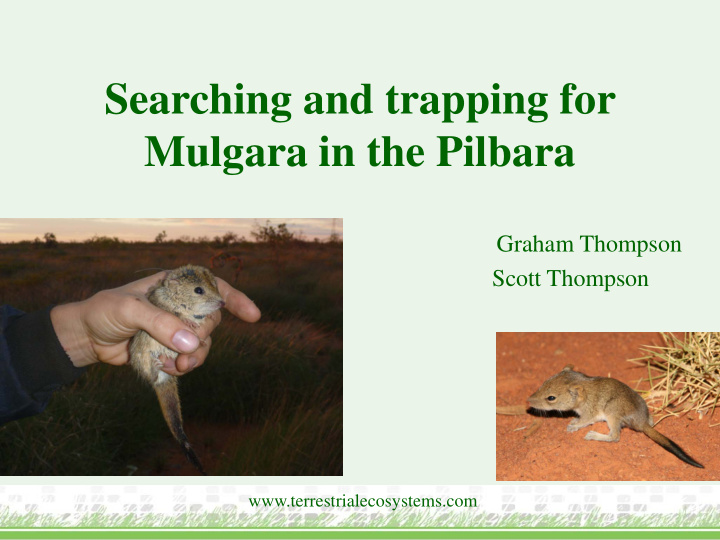



Searching and trapping for Mulgara in the Pilbara Graham Thompson Scott Thompson www.terrestrialecosystems.com
Dasycercus sp. www.terrestrialecosystems.com
Motivation for this research Failure to identify Mulgara habitat The above statement was taken from an EPBC referral in 2012 for a site within 1km of the area that has the highest recorded density of Mulgara in the Pilbara and where the habitat was almost identical! www.terrestrialecosystems.com
Motivation for this research Failure to identify Mulgara habitat This area probably supported Mulgara, and was not referred under the EPBC Act www.terrestrialecosystems.com
Motivation for this research Failure to detect burrows www.terrestrialecosystems.com
Motivation for this research Mis-identification of burrows www.terrestrialecosystems.com
Mulgara burrows How many people doing field work in the Pilbara have actually dug Mulgara from a • burrow or followed a Mulgara to a burrow and know what Mulgara burrows look like? www.terrestrialecosystems.com
Motivation for this research Insufficient trapping effort www.terrestrialecosystems.com
Mulgara burrows in the Pilbara • ‘D’ shaped entrance • Underground tunnels are generally 60-70mm wide, narrowest at about 40mm www.terrestrialecosystems.com
Simple Mulgara burrow Elevation not to scale Thompson and Thompson JRSWA 2007, 90:195-202 www.terrestrialecosystems.com
Complex Mulgara burrow Elevation not to scale Thompson and Thompson JRSWA , 2007, 90: 195-202 www.terrestrialecosystems.com
Complex Mulgara burrow Elevation not to scale Thompson and Thompson JRSWA , 2007, 90:195-202 www.terrestrialecosystems.com
Spinifex Hopping Mouse borrow Thompson and Thompson JRSWA 2007, 90: 111-113 www.terrestrialecosystems.com
Mulgara burrows in the Pilbara • Varying number of entrances • Entrances can be in the open or hidden under spinifex and shrubs • Burrows have interconnecting tunnels • Each Mulgara probably has multiple burrows www.terrestrialecosystems.com
Four case studies all are from the Pilbara, where: – the terrain is generally flat; – hard, sandy surface, often with surface stones; – low shrubs or hard spinifex of varying densities and heights; and – the landscape is often burnt. www.terrestrialecosystems.com
Case study 1 Thompson and Thompson , JRSWA , 2007, 90: 195-202 www.terrestrialecosystems.com
Case study 1 Methods Searched in June 2006 (22 person hrs – • 44ha) Trapped (750 trap-nights) and all burrows • were dug out in Jan 2007 Results Only 9 burrows found in the 2006 search • 65 burrows dug out after fire in Jan 2007 • 4 Mulgara trapped, 5 more dug out • Mulgara trapped on nights 1, 2, 3 and 4 • 190 trap-nights per Mulgara caught • Conclusions A lot of new burrow dug between June and • December or burrows were not found during searches in June 2006 Mulgara are difficult to trap in a resource • limited environment Digging out all burrows ensures you catch • all Mulgara Burrows easier to find after it was burnt • Thompson and Thompson , JRSWA , 2007, 90: 195-202 www.terrestrialecosystems.com
Case study 2 Thompson and Thompson, Australian Mammalogy , 2008, 30: 65-70 www.terrestrialecosystems.com
Case study 2 Methods 9,900 trap-nights (Jan-Feb 2007, Jun • 2007) in 210ha Results Very few Mulgara burrows seen • 50 Mulgara trapped • 220 trap-nights per Mulgara • 395 D. rosamondae , 1 N. alexis, • 27 P. desertor , 179 M. musculus, and 1,212 P. hermannsburgensis trapped Conclusions Mulgara passed multiple baited traps • on multiple nights before they were caught Mulgara are difficult to trap, even in • areas of high density May not be living in ‘typical’ burrows • or burrows Thompson and Thompson, Australian Mammalogy , 2008, 30: 65-70 www.terrestrialecosystems.com
Case study 3 www.terrestrialecosystems.com
Methods Case study 3 Traps set at 25m centres for 5 or 8 • nights (May 2013) Traps set at 25m centres • 3,367 trap-nights • Results 2 Mulgara caught on nights 3 and 5 • 3 burrows recorded that could have • been N. alexis or D. blythi 23 P. desertor , 24 M. musculus , • 30 D. rosamondae , 26 N. alexis, and 46 P. hermannsburgensis caught Conclusions Mulgara passed multiple baited traps • on multiple nights before they were caught Burrows are difficult to locate in • dense vegetation www.terrestrialecosystems.com
Case study 4 www.terrestrialecosystems.com
Methods Case study 4 1,881 baited traps, 9,740 trap-nights • Traps set at 25m centres • Results 2 Mulgara caught on nights 6 • and 7 19 D. rosamondae , 430 N. alexis , • 25 M. musculus , 17 P. desertor , 196 P. hermannsburgensis caught 3 N. alexis burrows found • Conclusions Mulgara passed multiple baited traps • on multiple nights before they were caught Burrows are difficult to locate in • dense vegetation www.terrestrialecosystems.com
Case study conclusions searching in mature, high or dense spinifex and low shrubs resulted in • many burrows not being detected; it was relatively easy to misidentify burrows used by Mulgara; • Mulgara passed multiple baited traps on multiple nights before they were • caught; in a high density population a minimum of 200 trap-nights / individual was • necessary to capture most Mulgara; and five nights of trapping was not sufficient to catch all Mulgara in an area • when traps were placed at 25m centres (16 traps per ha). www.terrestrialecosystems.com
Recommendations Assuming that Mulgara are living in burrows , searches to record the • presence of Mulgaras in an area should only occur when: – the height of spinifex or shrubs is less than 50cm; – the vegetation cover is less than 40%; and – the search effort is greater than two persons/hr/ha. In areas where the height of spinifex and shrubs is greater than 50cm and • the vegetation cover greater than 40%, then the area should be trapped instead of grid searching; www.terrestrialecosystems.com
Recommendations The minimum trapping effort to detect or remove all Mulgaras from an area • should be 16 traps per ha (25m centres) with traps set for a minimum of seven nights; and When the purpose of the trapping program is to catch and/or record all • Mulgara in an area, trapping should cease when no Mulgara have been caught within 400m of the trap for three consecutive nights. www.terrestrialecosystems.com
Recommend
More recommend